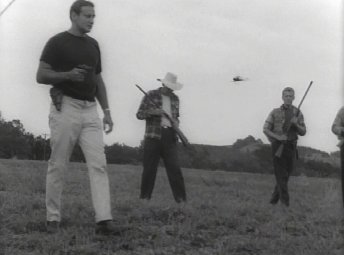|
|
|
|
Review
by Brook Kennon In
1968, a small group of friends in the business of making commercials and
industrial shorts wanted to try their hands at “real” movie-making.
Given the recent explosion of the exploitation and horror film market,
led in the USA by godfather of gore, Herschel Gordon Lewis, it was
decided that a horror film stood the best chance of being seen and maybe
even making some money. George Romero and John Russo came up with an
idea, and the group scraped together just over $100,000 and got started.
With money tight, they used local talent, friends, and even investors in
the film as actors. One of the investors was a butcher who provided the
blood n’ guts for the operation. No one could have guessed that from
these humble beginnings would emerge what is, arguably, the greatest of
American horror films. A movie who’s negative was once stored in the
basement of a Pittsburgh ad agency, now resides in the Library of
Congress’ National Film Registry. |
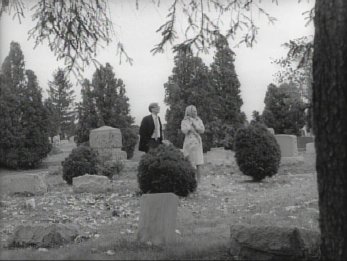 |
| Shot
in stark black & white, the film begins with Johnny and Barbara,
brother and sister, traveling for the annual visit a parent’s grave.
This immediately sets an oppressive mood that will be maintained
throughout. In a graveyard, the feeling of our own mortality and the
pain of lost loved ones are very close. Johnny reacts to this by making
jokes, his “they’re coming to get you Barbara” is perhaps the
films most memorable line. Barbara is saddened by her memories and
disgusted by Johnny’s lack of respect. All of that is forgotten,
though, as we see a figure in the distance, a caretaker perhaps? We
suddenly notice that the environment is devoid of sound. The figure
comes near, moving slowly but inexorably forward. His face is frozen and
expressionless. His eyes are dead. He raises his arms and attacks
Barbara. Johnny is killed in the struggle and Barbara flees. |
|
| Barbara
ends up at a farmhouse, and finding the door open rushes in, in shock
from her brother’s death and the attack. Ben, a man of action, who has
fled from town when the undead zombies, humans risen from the grave,
began an attack en masse, soon joins her. He was forced to stop because
his truck was almost out of gas. We quickly find out that they are not
alone in the house. In the basement is a relative of the farmhouse’s
owner, Tom, and his girlfriend, Judy. With them are a family, Harry and
Helen Cooper and their daughter Karen, who came here when their car ran
out of gas and a zombie bit Karen. Harry is volatile and immediately
clashes with Ben, while at the same time, the number of zombies outside
the house is growing. |
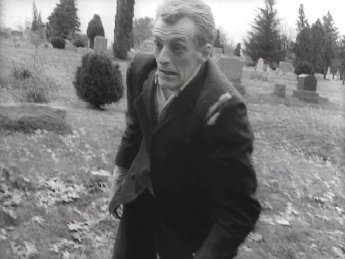 |
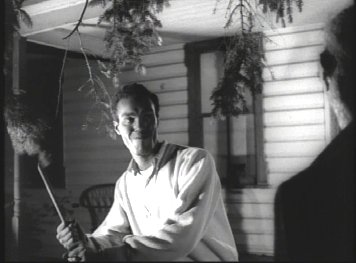 |
Night
of the Living Dead (NOTLD) creates its terror by making us, the
audience, feel as trapped as the seven people in the farmhouse. The
feelings of helplessness and confusion in the face of an enemy you don’t
understand are palpable. But George Romero goes even further, not
content with merely the monsters outside the house; there is also a
threat from within. The stress these characters are under results in
clashes of personality, ego, race (Ben being African-American), and the
basic human capacity for self-destruction. Like its two classic
predecessors, Alfred Hitchcock’s PSYCHO and Michael Powell’s PEEPING
TOM, NOTLD works as much a study of primal human psychology as it does
as a horror film. |
| But
make no mistake; NOTLD is nothing if not frightening. The feelings of
horror build slowly throughout the film, bursting forth on occasion, and
dropping back to give us a break, but also to continue to build in
increasing intensity. We see the zombies, slowly moving forward, having
bones broken or body parts cut off is no deterrent. They are driven to
consume human flesh, as we will later see in graphic detail. This is
contrasted by the humans in the house, frantically at work creating
defenses and finding weapons. At times working together, but just as
often Ben and Harry are at each other’s throats. The dissension within
seems to be as deadly as the terror waiting outside. |
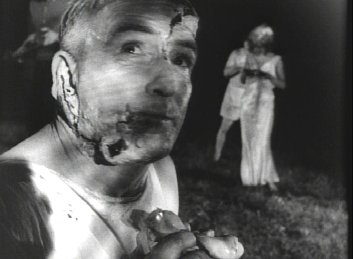 |
|
|
The brilliance of the film, though, is in its ability to work as social commentary. It is a child of the 60’s, when American society was wrought with dissension and confusion. The Vietnam War, assassinations, race riots, civil rights; the American dream of the 50’s was quickly becoming the nightmare world of NOTLD. As in the film, society responded to these adversities, not with a “New Deal” or a WWII uniting, but with pettiness, violence, apathy, hate, and helplessness. The Cold War was at full blast and our capacity for self-destruction never more apparent. This is the brutal reality of NOTLD, where sheriffs with dogs and redneck’s hunt zombies for sport, while students and Freedom Marchers were being beaten and having water hoses turned on them in the American South. The film closes with a magnificent montage of images that drive home this black as night view of humanity as its own worst enemy. As a character will state in Romero’s equally masterful sequel, DAWN OF THE DEAD, in answer to the question who or what are the zombies, “They’re us. We’re them and they’re us.” |

